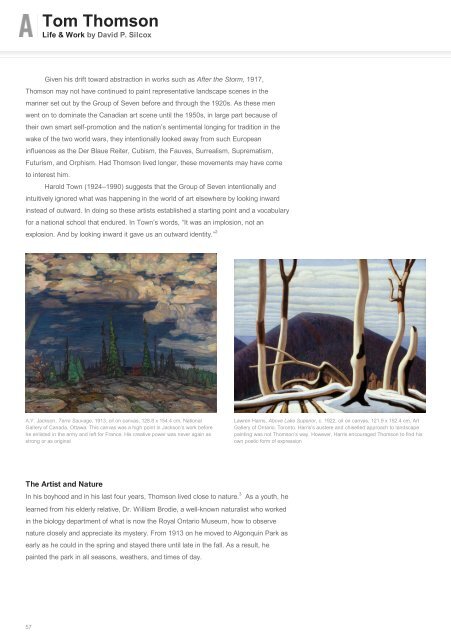You also want an ePaper? Increase the reach of your titles
YUMPU automatically turns print PDFs into web optimized ePapers that Google loves.
<strong>Tom</strong> <strong>Thomson</strong><br />
Life & Work by David P. Silcox<br />
Given his drift toward abstraction in works such as After the Storm, 1917,<br />
<strong>Thomson</strong> may not have continued to paint representative landscape scenes in the<br />
manner set out by the Group of Seven before and through the 1920s. As these men<br />
went on to dominate the Canadian art scene until the 1950s, in large part because of<br />
their own smart self-promotion and the nation’s sentimental longing for tradition in the<br />
wake of the two world wars, they intentionally looked away from such European<br />
influences as the Der Blaue Reiter, Cubism, the Fauves, Surrealism, Suprematism,<br />
Futurism, and Orphism. Had <strong>Thomson</strong> lived longer, these movements may have come<br />
to interest him.<br />
Harold Town (1924–1990) suggests that the Group of Seven intentionally and<br />
intuitively ignored what was happening in the world of art elsewhere by looking inward<br />
instead of outward. In doing so these artists established a starting point and a vocabulary<br />
for a national school that endured. In Town’s words, “It was an implosion, not an<br />
explosion. And by looking inward it gave us an outward identity.”<br />
2<br />
A.Y. Jackson, Terre Sauvage, 1913, oil on canvas, 128.8 x 154.4 cm, National<br />
Gallery of Canada, Ottawa. This canvas was a high point in Jackson’s work before<br />
he enlisted in the army and left for France. His creative power was never again as<br />
strong or as original<br />
Lawren Harris, Above Lake Superior, c. 1922, oil on canvas, 121.9 x 152.4 cm, Art<br />
Gallery of Ontario, Toronto. Harris’s austere and chiselled approach to landscape<br />
painting was not <strong>Thomson</strong>’s way. However, Harris encouraged <strong>Thomson</strong> to find his<br />
own poetic form of expression<br />
The Artist and Nature<br />
In his boyhood and in his last four years, <strong>Thomson</strong> lived close to nature. As a youth, he<br />
learned from his elderly relative, Dr. William Brodie, a well-known naturalist who worked<br />
in the biology department of what is now the Royal Ontario Museum, how to observe<br />
nature closely and appreciate its mystery. From 1913 on he moved to Algonquin Park as<br />
early as he could in the spring and stayed there until late in the fall. As a result, he<br />
painted the park in all seasons, weathers, and times of day.<br />
3<br />
57


